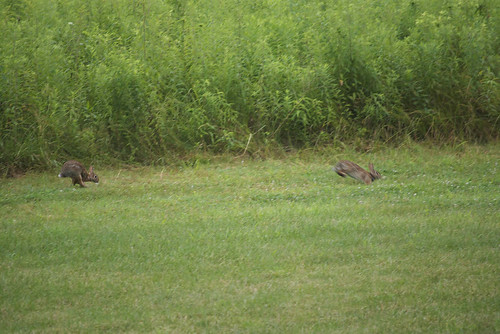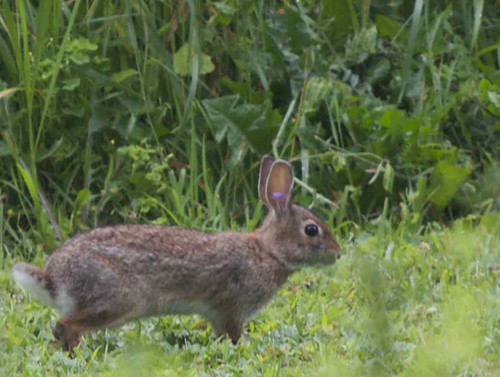
Playtime at the Cottontail Farm. Photo courtesy of owner Tom McAvoy
Pull a rabbit out of a hat. If only it were that simple!
For thousands of years, New England has been home to its own unique rabbit – the New England cottontail. The at-risk bunny once lived in a territory that extended from southeastern New York and northward into Vermont and southern Maine. Over the past decades, the cottontail’s territory has gotten significantly smaller, losing about 86 percent of its range since the 1960s.
Next month, the U.S. Fish and Wildlife Service (FWS) will announce whether to list the cottontail under the Endangered Species Act.
Why the decline in population? It’s because of habitat loss, both as forests mature and lands holding habitat are divided and developed. The New England cottontail depends on younger forests, called early successional forests, for food and sanctuary. Dense forests keep the rabbit safe from predators and provide places to rear young.
To combat the cottontail’s population decline, USDA’s Natural Resources Conservation Service (NRCS) and FWS and other groups have been working together to restore its habitat.
Through its Working Lands for Wildlife (WLFW) partnership, NRCS has provided technical and financial assistance to landowners, helping them restore 5,775 acres of cottontail habitat during the past three years. These investments help make private lands an important part of the recovery plan for this species.
WLFW has been highly successful in Connecticut. For example, the Avalonia Land Conservancy worked with NRCS to create early successional habitat on their Peck and Callahan preserves. The project focused on the property of two adjoining lands, both located in a focus area near locations where the species has been documented. NRCS helped the conservancy and landowners cut about 22 acres, removing enough canopy to allow the understory to regenerate. Then they created brush piles, which is instant cottontail habitat.
Meanwhile, the Magnuson family learned that their land near Lebanon, Connecticut, could play a crucial role in tying together cottontail habitat. The long-time conservation-minded family worked with NRCS to develop 12.5 acres of early successional habitat through the Environmental Quality Incentives Program, one of the Farm Bill conservation programs available to landowners. The family removed trees and created 33 brush piles.
In Lisbon, Connecticut, Dr. Chris Glenney worked with NRCS to turn land that had become overgrown into prime cottontail habitat. Glenny and NRCS cleared the land and sowed seedlings, creating cottontail-friendly early successional habitat on 24 acres. Glenny met his goal of restoring his land to the way it had been, benefitting his land and the bunny.
Conservation to help the New England cottontail is making a big difference in Connecticut and other states in the region. And there’s one thing for certain – there are no magic tricks here, just good old fashioned teamwork and a desire to protect one of New England’s own.
Learn more about NRCS’ wildlife conservation efforts. To get started with NRCS, visit your local USDA Service Center or www.nrcs.usda.gov/GetStarted.

This New England Cottontail is easily identified by the purple ear tag used for tracking purposes. Photo courtesy of Cottontail Farm owner Tom McAvoy
No comments:
Post a Comment
Note: Only a member of this blog may post a comment.